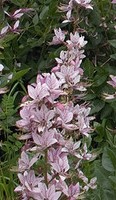 Also called dittany and burning bush, gas plant is a herbaceous perennial with a woody base and is native to southwestern Europe and Asia where it lives in forests edges, fields, and meadows. It produces volatile oils that can be ignited on hot day giving rise to two of its common names. The glossy, light green pinnate leaves have nine to eleven leaflets that are finely toothed, covered with translucent dots, and give off a lemony smell when crushed. The lemony scent is not surprising since the plant belongs to the same family as lemons (Rutaceae) but the taste is acrid rather than sour. The fragrant flowers are one inch long and white, pink, or purple with long stamens that extend beyond the petals. They are carried in terminal racemes and appear in early summer. Plants grow best where nights are cool and form large clumps with time. They are very long lived but are difficult to propagate and resent being moved. The variety purpureus has soft mauve petals with darker veins is especially attractive. The spikes of flowers are striking in arrangements and last well in water and the star-shaped seed pods are attractive in dried arrangements.
Also called dittany and burning bush, gas plant is a herbaceous perennial with a woody base and is native to southwestern Europe and Asia where it lives in forests edges, fields, and meadows. It produces volatile oils that can be ignited on hot day giving rise to two of its common names. The glossy, light green pinnate leaves have nine to eleven leaflets that are finely toothed, covered with translucent dots, and give off a lemony smell when crushed. The lemony scent is not surprising since the plant belongs to the same family as lemons (Rutaceae) but the taste is acrid rather than sour. The fragrant flowers are one inch long and white, pink, or purple with long stamens that extend beyond the petals. They are carried in terminal racemes and appear in early summer. Plants grow best where nights are cool and form large clumps with time. They are very long lived but are difficult to propagate and resent being moved. The variety purpureus has soft mauve petals with darker veins is especially attractive. The spikes of flowers are striking in arrangements and last well in water and the star-shaped seed pods are attractive in dried arrangements.
Cutting: Needs no special treatment.
Conditioning: Give a long drink in warm water.
Preserving: Seed heads may be left on the plants to dry or hung upside down in a dry place to dry.
Cultivation:
-
Size: 2-3’ H x 1.5-2.5’ W
Light: Full sun; tolerates some shade
Soil: Fertile, consistently moist, well-drained; somewhat drought tolerant once well established
Hardiness: Zones 3-8
Propagation: Difficult with any method; fresh seed planted in fall, division, root cuttings